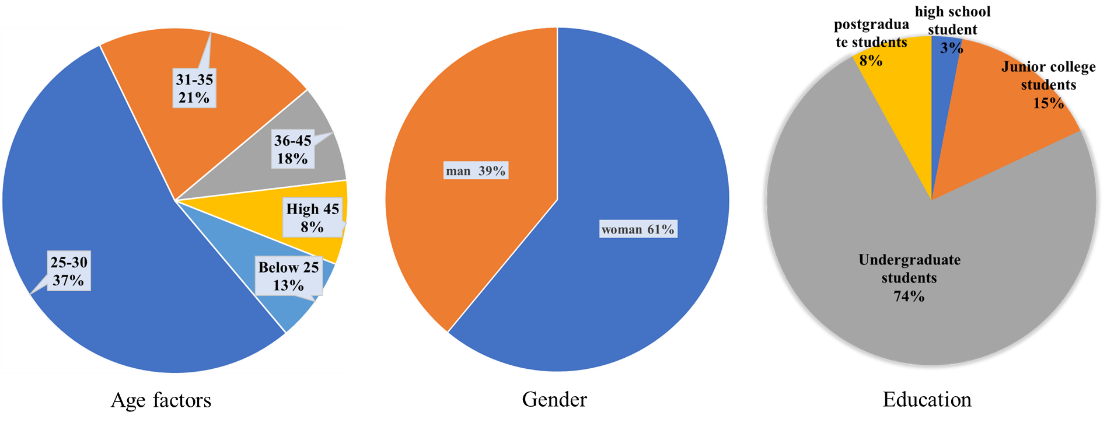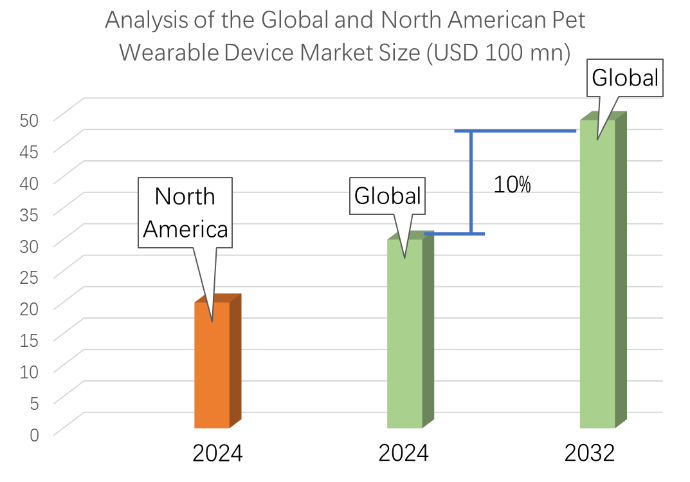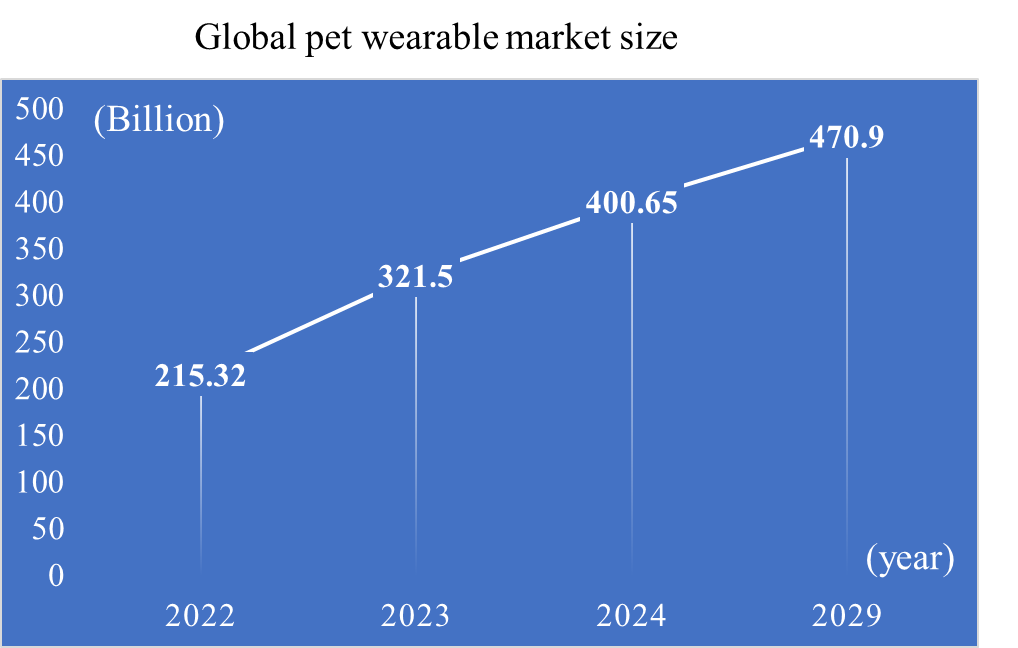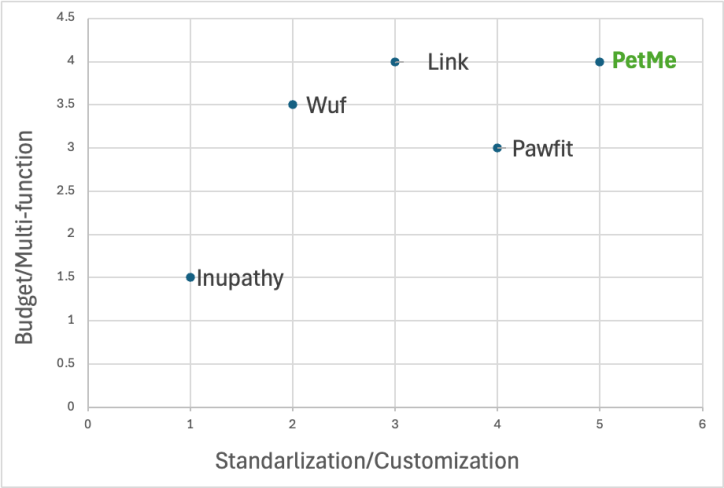1. Introduction
With the increasingly close relationship between pets and humans, pets are no longer just animals in people's minds, but have become their closest friends or family. The transformation of this relationship has raised higher requirements for pet-related monitoring devices. The global pet smart products market is growing strongly, with an expected market value of over 35 billion US dollars by 2032. Among them, North America dominates with a market share of 46%, and the smart feeder market is relatively large. The European market share is 22%, and Germany is expected to occupy a larger share. Pet smart products include categories such as smart feeding, smart cleaning, smart monitoring, and smart wearables, with consumer trends trending towards personalization and intelligence.
Smart pet wearable devices refer to devices specifically designed for pets that can collect physiological and behavioral data through various sensors and communication technologies, and analyze it through intelligent algorithms to provide real-time information and suggestions on pet health, behavior, activities, and other aspects for pet owners. These devices typically include, but are not limited to, health monitoring, activity tracking, behavioral analysis, remote interaction, health advice, and social function.
1.1. Current situation and trends of pet products market
The current state of this market is prominently manifested in the continuous enhancement of the quality of life for pets by consumers and the growing prevalence of the concept of regarding pets as family members. In recent years, as urbanization has advanced at a significant pace and living standards have substantially improved, an increasing number of families, approximately 30% more compared to a decade ago, according to a recent survey, are opting to keep pets. This has consequently fueled the expansion of the pet product market, which has witnessed an annual growth rate of around 15% in the past five years. Modern people's focus on pets is not confined to fulfilling basic necessities but also encompasses providing them with higher-quality and more diverse life experiences. For instance, many pet owners now seek out pet hotels that offer luxurious accommodations and personalized services during their travels. This tendency has given rise to a plethora of innovative pet products in the market, thus catering to the diverse demands of consumers regarding pet life. Simultaneously, with the swift development of intelligent technology, consumers' appetite for smart pet products is also on the rise. Take the smart pet feeder as an example, which allows pet owners to control feeding times and portions remotely, and its sales have doubled in the past two years. This growing demand presents both new opportunities and challenges to the market.
1.2. Pet health monitoring
Contemporary intelligent pet products are progressively zeroing in on the behavioral modalities and habits of pets. Through the utilization of advanced sensors and sophisticated data analysis technology, these products vigilantly monitor and astutely interpret the activities of pets, thereby proffering pet owners with highly valuable and precise information concerning their pets' health conditions. This empowers pet owners to comprehensively understand their pets' sleep regimens and expeditiously detect any telltale signs of sleep disturbances or restiveness. Additionally, the in-depth analysis of pet behavior data has the capacity to uncover aberrant behaviors exhibited by pets, such as anxiety, depression, or malaise, thus facilitating pet owners in implementing efficacious measures to ameliorate their pets' emotional states and behavioral patterns.
1.3. Market demand and consumer expectations
With household pets being progressively regarded as essential constituents of families, the market demand has taken on diverse and individualized characteristics. Consumers now expect pet products to not only satisfy basic necessities such as food, shelter, and healthcare but also to present more convenient and intelligent functions. To illustrate, consumers yearn for pet food that comes in a wider array of flavors and incorporates specialized formulas, thus meeting the taste preferences and health needs of their furry companions. Additionally, an increasing number of pet owners are deeply concerned about the safety and health of their pets. This has led to a significant escalation in the requirements for safety and quality standards. Simultaneously, consumers highly anticipate that pet products can more effectively enhance their emotional connection with pets. For example, by providing more engaging interactive and entertainment options, which has consequently driven the rise of intelligent pet products. This trend reflects the evolving relationship between pets and their owners and the corresponding shift in consumer expectations within the pet product market.
1.4. The focus of this study
There are already many pet locator products on the market, such as Whistle, Tractive and other brands, which have a certain level of popularity. These products have, to some extent, met the needs of users, but there are still some issues in terms of positioning accuracy, product functionality, user experience, and so on.
To overcome the above challenges, we have designed a new personalized intelligent collar, which is mainly targeted at consumers who have a high demand for pet care. This intelligent collar can not only monitor the health of pets in real time, but also effectively prevent pets from getting lost. Personalization mainly refers to: young pets need to monitor their exercise status, while older pets need to monitor their physical functions. In addition, this smart collar can also transmit various information about pets into the community, making it convenient for pet owners to exchange experiences with each other. The characteristics of the product mainly include high precision positioning, personalized customization, high safety, and long battery life. It is worth noting that our product supports pet owners to DIY the appearance of the device. Compared to the current single-function collars on the market, our designed collars can achieve the purpose of monitoring different types and ages and meeting the various needs of pets.
2. Literature review
More and more pet owners are treating their beloved pets like family and constantly investing in their safety, health, and well-being, especially by using online and digitally connected products to ensure the quality of their pets' lives and entertainment [1]. Nowadays, not only humans but also pets' lives are becoming increasingly intelligent. Worldwide, many countries and regions have entered the era of intelligence-driven by technological and scientific advancements in pet care [2]. While further upgrading the pet care experience, this has also enabled the rapid development of the smart pet product market.
The personalized functions reasons are why pet owners are more willing to purchase pet supplies online and pay for veterinary remote medical care. First of all, with the popularization of the Internet and the development of e-commerce, online shopping has become a convenient and fast way [3]. Pet owners can easily purchase various pet supplies through online platforms, saving time and energy. In addition, online shopping provides more choices and comparisons, making it easier for pet owners to find products that are suitable for their pets [4].
With the increase in the number of pets and the increasing attention of pet owners to pet health, the market size of smart pet wearable devices continues to expand. Product types include smart collars, smart straps, smart trackers, smart feeders, smart water dispensers, etc. The technical application integrates GPS positioning, WiFi connection, Bluetooth communication, heart rate monitoring, activity tracking, and other technologies. The user group is mainly concentrated among pet owners, especially those who have high requirements for pet health and safety [5].
The concept of personalization is an important trend in current product design and marketing. The use of the concept of "self-designed" can meet consumers' needs for personalization and enhance the added value and competitiveness of products [6]. For smart pet wearables products, personalized design customization services can be provided to meet pet owners' pursuit of product uniqueness and personalization. For example, online design tools or platforms can be provided to allow pet owners to freely design the appearance, functions, etc., of Smart Pet Wearables according to their preferences and needs, achieving customized production [7]. Personalized design can make products more in line with consumers' personalized needs, enhance their sense of identification and loyalty to the product, and improve the product's market competitiveness and sales revenue.
Pet owners have increasingly personalized demands for smart devices and hope that the devices can provide customized services [8]. The health monitoring function of smart devices is receiving increasing attention, such as heart rate monitoring, body temperature monitoring, etc. Enhanced interaction between devices and pets, such as game interaction between devices and pets. Provide analysis services based on pet activity data to help pet owners better understand their pets' health status.
3. Segmentation
The product is mainly targeted at pet owners, veterinary clinics, and pet insurance companies located in first and second-tier cities. This type of customer mainly includes busy schedules, students, and white-collar. Among these users, pets usually have a strong companionship effect, and they often regard their pets as their friends, children, and family (Table 1). Therefore, they usually require devices to track and report on the daily behavior and health of pets. Pet types include dogs, cats, birds, and fish et al.
|
Users |
Requirements |
|
Busy pet owners |
Automated pet care solutions, monitoring, and interaction devices when going out to work |
|
First-time pet owners |
Comprehensive guidance on pet care, beautiful design |
|
Health-conscious pet owners |
In families with children, the pet is a companion to their growing kid's safety, hygiene, and growth record. |
|
Multi-pet owners |
Tracking each pet's health conditions, appointments, and medications, GPS. |
|
Pet owners with communication problems |
Detailed health records to communicate with veterinarians, tailored, user-friendly options |
|
Pet care professionals |
Monitoring data remotely, diagnosing issues, and tracking recovery progress |
The army of pet owners in our country is constantly expanding, and consumer concepts are becoming increasingly mature. Age factors, gender, and education have led to the advancement of pet concepts from "traditional pet ownership" to "scientific pet ownership" (Fig. 1). According to the demographic background distribution of Chinese pet owners under different backgrounds showed that people within the age range of 25~30 prefer pets, and compared to men, women prefer to keep pets. At the same time, people with different educational backgrounds also have different levels of love for pets, with those with undergraduate education preferring to keep pets.

The global pet wearable device market is expected to reach $3 billion by 2024, with a compound annual growth rate of over 10% from 2024 to 2032 due to an increase in the number of pet technology solution manufacturers. In 2024, the North American pet wearable device market dominated with a market size of $2 billion, mainly due to the high importance pet owners place on pet health and wellness (Fig.2). In addition, there has been a significant increase in spending on high-quality event tracking solutions in the region.

The market research report on China's pet wearable industry covers statistical analysis of historical market data over the past five years and predictions of future market capacity growth trends. The global pet wearable market size will reach 21.532 billion yuan (RMB) in 2022, and the pet wearable market size in China will reach 100 million yuan. The report predicts that the global pet wearable market will reach 47.09 billion yuan by 2029, with an estimated compound annual growth rate of 13.89% during the forecast period(Fig.3).

4. Product positioning
The design of pet wearable devices aims to provide pet owners with more convenience and safety assurance. These devices typically include pet trackers, smart feeders, health monitoring devices, etc., to meet the needs of pet owners for pet safety, health, and daily management. There are already many pet locator products on the market, such as Link, Wuf, and other brands, which have a certain level of popularity. These products have, to some extent, met the needs of users, but there are still some issues in terms of positioning accuracy, product functionality, user experience, and so on. Therefore, we believe that through our efforts, we can establish our brand image in the market and win user recognition.
Our intelligent pet locator is mainly targeted at consumers who have a high demand for pet care. The product features include: Our intelligent pet locator is mainly targeted at consumers who have a high demand for pet care. The characteristics of the product mainly include:
1. High-precision positioning: Through satellite positioning technology, high-precision real-time positioning is achieved to ensure that pet owners can always grasp the location of their pets
2. Personalized customization: Install different programs on the device and set different app content to meet the different needs of each customer.
3. High safety: The product has functions such as waterproofing and loss prevention, which can ensure the safety of pets during outdoor activities.
4. Long battery life: The product adopts a high-capacity battery design, which has a long battery life and does not require frequent charging(Fig.4).

Business model product sales:
1. Product sales are conducted through online and offline channels.
2. Membership services: Provide users with membership services, including location tracking services, security reminder services, etc.
3. Advertising placement: Revenue is generated through platform advertising and other means.
The marketing strategy mainly includes:
1. Online promotion: promoting products through social media, search engines, and other platforms.
2. Offline activities: participate in pet exhibitions, organize offline pet events, and promote products through other means.
3. Channel cooperation: Collaborate with pet stores, pet hospitals, etc. to jointly promote products.
5. Data analysis
5.1. PetMe vs PawFit vs link
|
Values |
|
|
Attribute 1:Battery Life |
7/10/15 days |
|
Attribute 2:Functionality |
Basic/Advanced/Premium |
|
Price |
300/450/600/750/900/1050/1200/1350/1500 RMB |
Price range and product positioning: The price range of pet smart wearable devices is relatively large, ranging from a few hundred yuan to several thousand yuan. Products at different prices have differences in functionality, materials, design, etc., and need to be positioned according to consumer needs.
Value manifestation: The value of smart wearable devices for pets mainly lies in the following aspects: improving the quality of life of pets, enhancing pet health monitoring, and strengthening interaction between pet owners and pets. These values can enhance consumers' willingness to purchase and loyalty.
Cost-effectiveness evaluation: For consumers, cost-effectiveness is an important consideration when choosing pet smart wearable devices. When the price difference is not significant, consumers are more inclined to choose products with more comprehensive functions and better user experience. Therefore, manufacturers need to find a balance between price and value to improve the cost-effectiveness of their products(Table 2).
5.2. Correlation coefficient

Based on the above experimental results of Fig.5, it can be concluded that the battery life of pet collars is the least attractive to pet owners, which indicates that our designed collars can choose existing batteries without spending too much effort to improve battery life. The multifunctionality of collars is particularly attractive to pet owners, mainly because it makes it easier to monitor pet behavior. The most attractive factor for pet owners is the price. Therefore, our products need to offer the most favorable price while ensuring that they meet the requirements of pet owners as much as possible.
5.3. Regression
By understanding users' needs for Smart Pet Wearables, we developed three products with different functions and conducted a survey on these three products in the form of a questionnaire. The research results are as follows:
|
coef |
std err |
t |
P>|t| |
[0.025 0.975] |
||
|
const |
0.5418 |
0.060 |
9.070 |
0.000 |
0.425 |
0.659 |
|
Attribute 1 |
0.0187 |
0.004 |
4.935 |
0.000 |
0.011 |
0.026 |
|
Attribute 2 |
0.1448 |
0.015 |
9.459 |
0.000 |
0.115 |
0.175 |
|
Price |
-0.0007 |
3.23e-05 |
-22.468 |
0.000 |
-0.001 |
-0.001 |
As shown in Table 3:
Buyer=0.5418-0.07%×Price+1.87%×Battery Life+14.48%×Functionality
Based on the research results, we have come to the conclusion that:
Recommended price increases due to functionality upgrades: ¥ 0~206.86
Extra charges for better batteries: ¥ 0~80.14/133.57
Based on the research results, we conclude that the growth of personalized demand has brought new opportunities to the pet smart wearable device market. With the increasing concern of pet owners for their pets' health and welfare, their demand for smart wearable devices for pets has become more personalized and diversified. For example, some pet owners may be more concerned about their pets' physical activity and health status, while others may be more focused on their pets' safety and positioning functions. To meet these diverse needs, market participants need to closely monitor changes in consumer demands and continuously innovate products and services to provide personalized solutions.
6. Conclusions
The rise of smart pet wearables reflects the evolving bond between pets and humans, where pets are now seen as integral family members. Smart pet wearable devices integrate various sensors and communication technologies to provide real-time monitoring, health tracking, location tracking, and other functions for pets, helping pet owners better take care of their pets. With the advancement of technology and the growth of market demand, the industry is expected to usher in more development opportunities. Our study on the personalized intelligent collar underscores the market's shift towards devices that cater to the specific needs of pets across different life stages, enhancing both health monitoring and owner-pet interaction. As the pet tech market surges, driven by advancements in technology and a growing consumer base, our innovative collar stands out with its high-precision tracking, customizable features, and user-friendly design. Looking ahead, the market is poised for further growth, with the potential for more personalized and intelligent pet care solutions. In the future, with the continuous advancement of technology and changing consumer demands, the pet smart wearable device market will continue to maintain a rapid growth trend.
References
[1]. Lukowicz P. From Backpacks to Smartphones: Past, Present, and Future of Wearable Computers [J]. IEEE Pervasive Computing, 2009, 8(3): 8-13.
[2]. Ji, Soo, Hong, et al. A Study on the Effect of Pet-Wearable Device"s Function Perception on Purchase Attitude and Intention Based on Technology Acceptance Model [J]. The Journal of Korean Institute of Communications and Information Sciences, 2017, 42(7): 1412-1421.
[3]. Teh K S, Lee S P, Cheok A D. Poultry. Internet: A Remote Human-Pet Interaction System: CHI EA 06, New York, NY, USA, 2006 [C].
[4]. Ladha C, Hammerla N, Hughs E, et al. Dog's Life: Wearable Activity Recognition for Dogs [C] //: Proc. Int. Conf. Ubiquitous Comp. (UbiComp), 2013.
[5]. Shaheen D H. Wireless Sensing Element Network-Based Pet Location Observation System for Domestic Situations [J], 2018.
[6]. Setiawan D, Sari M W, Hardyanto R H. Geofencing technology implementation for pet tracker using Arduino based on Android, 2021 [C]. IOP Publishing.
[7]. Jeong H, Lee J, Lee J, et al. A Remote-Monitoring System of Pets using a Wearable Device, 2020 [C]. Korean Society of Computer Information.
[8]. Widmar NO, Bir C, Slipchenko N, Wolf C, Hansen C, Ouedraogo F, Online Procurement of Pet Supplies and Willingness to Pay for Veterinary Telemedicine [J], Preventive Veterinary Medicine, 2020.
Cite this article
Kong,Y. (2025). Personalized Intelligent Collar: Meets the Various Needs of Pets and Pet Lovers. Advances in Economics, Management and Political Sciences,217,32-40.
Data availability
The datasets used and/or analyzed during the current study will be available from the authors upon reasonable request.
Disclaimer/Publisher's Note
The statements, opinions and data contained in all publications are solely those of the individual author(s) and contributor(s) and not of EWA Publishing and/or the editor(s). EWA Publishing and/or the editor(s) disclaim responsibility for any injury to people or property resulting from any ideas, methods, instructions or products referred to in the content.
About volume
Volume title: Proceedings of the 3rd International Conference on Financial Technology and Business Analysis
© 2024 by the author(s). Licensee EWA Publishing, Oxford, UK. This article is an open access article distributed under the terms and
conditions of the Creative Commons Attribution (CC BY) license. Authors who
publish this series agree to the following terms:
1. Authors retain copyright and grant the series right of first publication with the work simultaneously licensed under a Creative Commons
Attribution License that allows others to share the work with an acknowledgment of the work's authorship and initial publication in this
series.
2. Authors are able to enter into separate, additional contractual arrangements for the non-exclusive distribution of the series's published
version of the work (e.g., post it to an institutional repository or publish it in a book), with an acknowledgment of its initial
publication in this series.
3. Authors are permitted and encouraged to post their work online (e.g., in institutional repositories or on their website) prior to and
during the submission process, as it can lead to productive exchanges, as well as earlier and greater citation of published work (See
Open access policy for details).
References
[1]. Lukowicz P. From Backpacks to Smartphones: Past, Present, and Future of Wearable Computers [J]. IEEE Pervasive Computing, 2009, 8(3): 8-13.
[2]. Ji, Soo, Hong, et al. A Study on the Effect of Pet-Wearable Device"s Function Perception on Purchase Attitude and Intention Based on Technology Acceptance Model [J]. The Journal of Korean Institute of Communications and Information Sciences, 2017, 42(7): 1412-1421.
[3]. Teh K S, Lee S P, Cheok A D. Poultry. Internet: A Remote Human-Pet Interaction System: CHI EA 06, New York, NY, USA, 2006 [C].
[4]. Ladha C, Hammerla N, Hughs E, et al. Dog's Life: Wearable Activity Recognition for Dogs [C] //: Proc. Int. Conf. Ubiquitous Comp. (UbiComp), 2013.
[5]. Shaheen D H. Wireless Sensing Element Network-Based Pet Location Observation System for Domestic Situations [J], 2018.
[6]. Setiawan D, Sari M W, Hardyanto R H. Geofencing technology implementation for pet tracker using Arduino based on Android, 2021 [C]. IOP Publishing.
[7]. Jeong H, Lee J, Lee J, et al. A Remote-Monitoring System of Pets using a Wearable Device, 2020 [C]. Korean Society of Computer Information.
[8]. Widmar NO, Bir C, Slipchenko N, Wolf C, Hansen C, Ouedraogo F, Online Procurement of Pet Supplies and Willingness to Pay for Veterinary Telemedicine [J], Preventive Veterinary Medicine, 2020.









